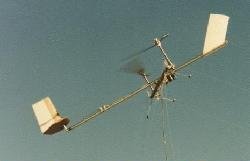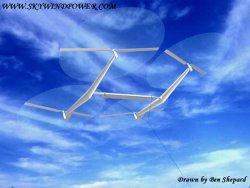Global Warming
September 2013 Berlin, Germany
Mission: To convert the power in high altitude winds
into clean energy for a better world.TM
The energy in the high altitude winds is far more than enough to meet the world's energy needs, and means of capturing this energy are available through a little further development of technologies that do not require any fundamental scientific breakthroughs.
The Sky's the Limit for Wind Power Conversion, Power Electronics Technology, August 2011TIME's Best Inventions of 2008
Sky WindPower's Flying Electric Generators on Popular Mechanics'
March 2011 cover
We recommend that you consider the peer reviewed paper published by the IEEE "Harnessing High Altitude Wind Power" IEEE Transactions on Energy Conversion Vol 22 No.1 March 2007 for which Bryan Roberts, was the lead author. Or consider the other tethered methods now being pursued by others described in our "Flying Electric Generators and Other Tethered Methods" section below.While the public is aware of the high winds in the jet stream, there is no need for the jet stream to be overhead in the sense as reported in weather forecasts. Think, rather, of the average winds which make a difference in the time flying coast to coast in the U.S. from east to west versus west to east. Tremendous energy can be captured from these average temperate zone winds, enough to supply the world's energy needs very economically.
Truly high energy winds are at altitudes miles above us, not just at a few hundred feet where they can be tapped by rotors on towers. This is clearly demonstrated in the form of detailed color charts calculated by Dr. Ken Caldeira, formerly of the Lawrence Livermore National Laboratory, now at the Carnegie Institute's Department of Global Ecology in Stanford, California. These charts show at what latitudes and altitudes this vast energy is to be found. We are indebted to him for permission to display these charts in the Global Wind Resources section of this website.
Australian Dr. Bryan Roberts has long been convinced that, by application of an appropriate technology, this high altitude wind energy can be captured. He set out to prove that long ago, and has demonstrated that Flying Electric Generator(FEG) technology is practical and should work at high altitudes. This is the "Flying Windmills" technology about which you may have read in publications or on the internet. Competition for tapping this high altitude wind energy is also in development elsewhere in the world, and we welcome that.
Please see pictures, upper right of a FEG that now retired Professor Roberts and his colleagues demonstrated at low altitude years ago, and lower right of an artist's conception of a flying electric generator.
In mass use, our calculations show that FEGs of Roberts' design should be able to produce electricity at a life cycle cost COMPETITIVE WITH THE LOWEST COST ENERGY SOURCES.
If all costs are considered, including the true costs of nuclear fission and the external costs of fossil fuel energy sources, AIRBORNE WIND ENERGY WOULD BE THE WORLD'S CHEAPEST ENERGY SOURCE. (Possible exceptions are limited hydro sources and limited situations where surface-based wind turbines may be the most economic for supplying relatively local needs.) On a large scale, our figures show that high altitude wind energy will be capable of supplying the world's needs at the best overall economics.
When it is realized that high altitude wind energy is capable of being the most economical large scale energy source for much of the world, market forces will lead to its gradually supplanting fossil fuels as well as an end to the debate on global warming - because this clean energy source will produce no greenhouse gases.

The total swept area for a Flying Electric Generator of the same megawatt rating as a ground based wind turbine is typically about a quarter as much.
Yet, the Flying Electric Generator would produce far more megawatt hours of electricity per year due to the much higher high altitude wind speeds and constancy.
Note: Our stock is not publicly traded.
For a first viewing of this website, we suggest that the "A B C" order of reviewing sections as listed to the left be followed. Larger View of Artists Drawing
Larger View of Artists Drawing 